Light-emitting diode (LED):
A light-emitting diode (LED) is a semiconductor device that emits visible light when an electric current passes through it. The light is not particularly bright, but in most LEDs it is monochromatic, occurring at a single wavelength. The output from a LED can range from red (at a wavelength of approximately 700 nanometers) to blue-violet (about 400 nanometers). Some LEDs emit infrared (IR) energy (830 nanometers or longer); such a device is known as an infrared-emitting diode (IRED).
Construction of a Light Emitting Diode:
The construction of a Light Emitting Diode is very different from that of a normal signal diode. The PN junction of a LED is surrounded by a transparent, hard plastic epoxy resin hemispherical-shaped shell or body which protects the LED from both vibration and shock.

However, not all LEDs are made with a hemispherical-shaped dome for their epoxy shell. Some indication LEDs have a rectangular or cylindrical shaped construction that has a flat surface on top or their body is shaped into a bar or arrow. Generally, all LED’s are manufactured with two legs protruding from the bottom of the body.
Light Emitting Diode Colours:
Light Emitting Diodes are made from exotic semiconductor compounds such as Gallium Arsenide (GaAs), Gallium Phosphide (GaP), Gallium Arsenide Phosphide (GaAsP), Silicon Carbide (SiC) or Gallium Indium Nitride (GaInN) all mixed together at different ratios to produce a distinct wavelength of color.
Different LED compounds emit light in specific regions of the visible light spectrum and therefore produce different intensity levels. The exact choice of the semiconductor material used will determine the overall wavelength of the photon light emissions and therefore the resulting color of the light emitted.
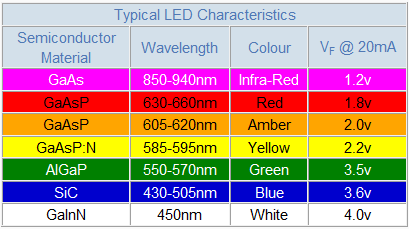
Types of Light Emitting Diode:
- Gallium Arsenide (GaAs) – infra-red
- Gallium Arsenide Phosphide (GaAsP) – red to infra-red, orange
- Aluminium Gallium Arsenide Phosphide (AlGaAsP) – high-brightness red, orange-red, orange, and yellow
- Gallium Phosphide (GaP) – red, yellow and green
- Aluminium Gallium Phosphide (AlGaP) – green
- Gallium Nitride (GaN) – green, emerald green
- Gallium Indium Nitride (GaInN) – near ultraviolet, bluish-green and blue
- Silicon Carbide (SiC) – blue as a substrate
- Zinc Selenide (ZnSe) – blue
- Aluminium Gallium Nitride (AlGaN) – ultraviolet
Light Emitting Diodes I-V Characteristics:
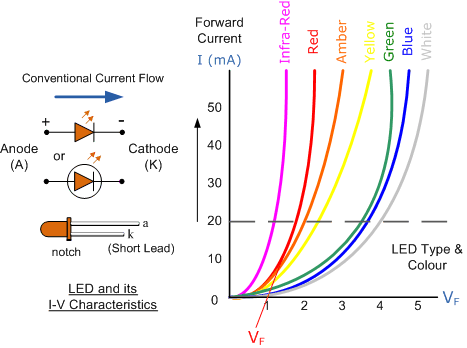
Before a light emitting diode can “emit” any form of light it needs a current to flow through it, as it is a current dependent device with their light output intensity being directly proportional to the forward current flowing through the LED.
Multi-coloured Light Emitting Diode:
LEDs are available in a wide range of shapes, colors and various sizes with different light output intensities available, with the most common (and cheapest to produce) being the standard 5mm Red Gallium Arsenide Phosphide (GaAsP) LED.
LED’s are also available in various “packages” arranged to produce both letters and numbers with the most common being that of the “seven segment display” arrangement.
Bicolour Light Emitting Diodes:
A bicolor light emitting diode has two LEDs chips connected together in “inverse parallel” (one forwards, one backward) combined in one single package. Bicolour LEDs can produce any one of three colors, for example, a red color is emitted when the device is connected with current flowing in one direction and a green color is emitted when it is biased in the other direction.
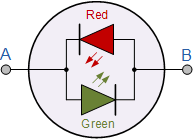
Tricoloured Light Emitting Diode:
The most popular type of tricolor light emitting diode comprises of a single Red and a Green LED combined in one package with their cathode terminals connected together producing a three terminal device. They are called tricolor LEDs because they can give out a single red or a green color by turning “ON” only one LED at a time.
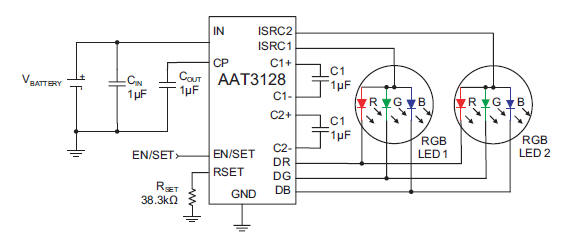
A Typical Seven Segment LED Display:
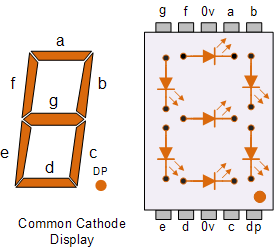
A 7-segment LED display provides a very convenient way when decoded properly of displaying information or digital data in the form of numbers, letters or even alpha-numerical characters and as their name suggests, they consist of seven individual LEDs (the segments), within one single display package
